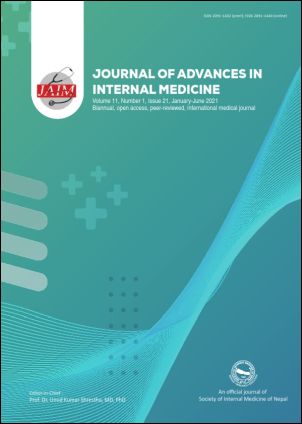Internal jugular vein distensibility: Rapid and reliable bedside assessment tool to predict fluid responsiveness in mechanically ventilated septic patients
DOI:
https://doi.org/10.3126/jaim.v11i1.48192Keywords:
Fluid responsiveness, Internal jugular vein, Mechanically ventilated patients, SepsisAbstract
Background and Aims: This study aims to evaluate whether respiratory changes in internal jugular vein (IJV) diameter predicts fluid responsiveness in mechanically ventilated patients with sepsis.
Methods: In this prospective observational analytic study, mechanically ventilated patients in septic shock received 7ml/kg of Normal Saline (NS) over 15 minutes. Patients were then categorized into two groups retrospectively; fluid responders (R), if there was an increment in Cardiac Index (CI) by more than or equal to 15% following fluid administration, and non-responders (NR) if the increase in CI was less than 15%. The primary outcome was respiratory changes in IJV diameter before and after fluid administration. Ultrasonographic assessment of IJV distensibility was carried out in all mechanically ventilated septic patients before and after fluid administration.
Results: In our study, 74 mechanically ventilated septic patients were enrolled. Among them, 29 (39.2%) patients were fluid responders whereas 45 (60.8%) patients were non-responders. Responders demonstrated higher IJV distensibility before volume expansion than non-responders (33.33% vs 16.9%; P <0.001). Significant reduction in this difference was observed following volume challenge in responders (33.33% to 20.18%). An IJV distensibility of >28.2% before fluid administration predicted the change in CI ≥15% with 90% sensitivity and 100% specificity with area under curve of 0.985 (CI 0.963 to 1.006).
Conclusion: Ultrasound evaluation of respiratory changes in IJV distensibility effectively predicts fluid responsiveness in mechanically ventilated septic patients.
Downloads
Downloads
Published
How to Cite
Issue
Section
License

This work is licensed under a Creative Commons Attribution 4.0 International License.
This license enables reusers to distribute, remix, adapt, and build upon the material in any medium or format, so long as attribution is given to the creator.




